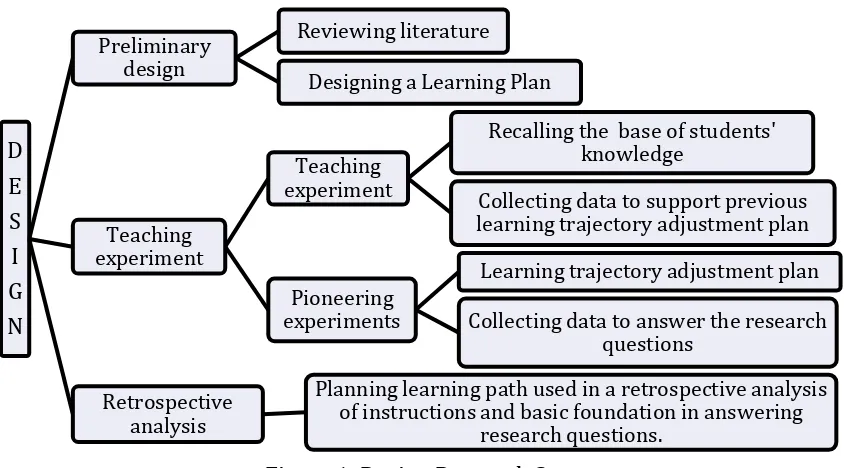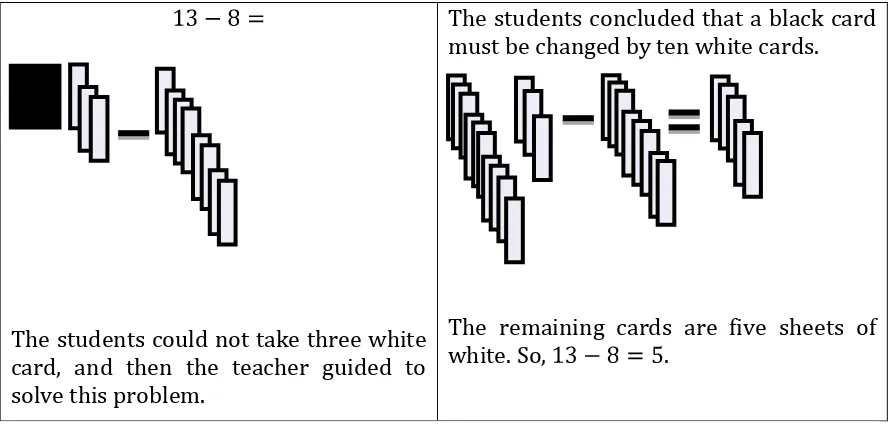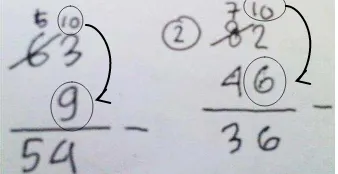306
THE USE OF GASING METHOD FOR TEACHING TWO-DIGIT
SUBTRACTION FOR 2
ndGRADE STUDENTS OF SDN CIHUNI II
TANGERANG
Petra Suwasti STKIP Surya
Abstract
Most students do not understand the concept of subtraction. These problems appear because the learning of mathematics is not meaningful for students. Based on this phenomenon, researcher is interested in designing a method of learning subtraction by using GASING method. The purpose of this research is to describe the role of a GASING method to improve students' understanding of two-digit subtraction from a concrete sample into an abstract symbol. As a result, the students are able to calculate mentally (calculate in their head, without scratching on paper) and do worksheets. The method is integrated with design research which consists of preliminary design stages, teaching experiment, and retrospective analysis. This research describes how the learning of subtraction with GASING method improves the understanding of 2nd grade students of SDN Cihuni II Tangerang. The results showed that the method could stimulate students to understand the concept of subtraction. Secondly, GASING method can enhance students' understanding of doing subtraction where the students are able to count more quickly and easily. The researcher should be able to transfer the design of learning to the teacher as the object of the research. Therefore the results of the research can be successful. In addition, the learning of subtraction by using GASING methods can be developed for multi digit number and another number operation.
Keywords: design research, GASING Method, subtraction
INTRODUCTION
Operation of addition and subtraction is basic knowledge for further study of mathematics (NCTM, 2000). The application of subtraction is also easily found in daily life today. However, in reality, many students are still struggling to work on subtraction problems (Dyah, 2009). The cause of this problem is the meaningless learning for students. Jensen (1998) said that the meaningless of learning will not be achieved if the teaching does not have a deep meaning and does not attract students’ attention. Therefore, it is necessary to create fun and exciting learning mathematics for students (Whitman, 2011). Surya (2012) showed that he had developed and implemented for learning and teaching mathematics that is called GASING (GAmpang, aSyIk, dan menyenaNGkan) or easy, fun and enjoyable. This method helps students learn math easily, fun, and enjoyable and also makes a meaningful mathematics,
whatever the person’s background is. Easy means students are introduced to
307 the use of props and games (extern factor) that make meaningful math. This learning, which began with the introduction of number and number operations, has been applied to Papuan students and has resulted many national and international olympiad winner (Surya, 2012). The philosophy behind GASING method are: (1) there are no stupid students, students have not received the opportunity to study with a good teacher and with a good methodology; (2) GASING method consists of step by step of learning, starting from a concrete into an abstract symbol; (3) there is a critical point if students are able to pass this critical point, students have no trouble anymore for the next subject. Therefore, the researcher designed subtraction learning with a GASING method for 2nd grade students in SDN Cihuni II Tangerang. Problem formulation in this research is How does the role of a GASING method help
the understanding of the 2nd grade students of SDN Cihuni II Tangerang on two-digit subtraction lesson? . This research was aimed to describe the role of GASING method
to help the understanding of 2nd grade students of SDN Cihuni II Tangerang on
308 Figure 1. Design Research Step
Data Sources were obtained from video, photos of learning activities and written data such as worksheets and sheets of observations. After that, the data were analyzed retrospectively with HLT as a guide. Data analysis was performed by the researcher and teachers (student of STKIP Surya). This research was conducted in September 2012. The objects were 30 students of grade 2 of SDN Cihuni II Tangerang and 2 students of STKIP Surya as teacher.
MAIN SECTION
The results of this research indicate that the use of GASING method assists students in learning the concepts of subtraction. GASING method consists of step by step of learning, starting from a concrete into an abstract symbol. Surya (2011:47) said that the learning of subtraction began with introducing the concept of one-digit subtraction with fingers which is the starting point in learning subtraction with GASING method. The next step was subtraction less than 10 (one-digit subtraction) without fingers. After that, subtraction number from 10 and then introduction of 10-pair. Subtraction 1 to 10 is a critical point of subtraction. The students’ ability to do subtraction 1 to 10 has an important role as a base for mastering further subtraction. After that, the students were guided to learn two-digit minus one-digit subtraction without regrouping and then two-digit minus two-digit with regrouping. The next step, the students guided to learn two-digit minus two-digit subtraction. The problem of two-digit subtraction appeared when ones of the subtrahends more than ones of the minuends. This is called subtraction with regrouping and then the students used
streak system to solve them. The students’ learning trajectory began from the use of
contextual issues until resolving subtraction by using streak system. The evaluation of learning is by calculate mentally (calculate in their head, without scratching on paper) and do worksheets. From all learning activities, researcher can conclude that students can understand the basic concepts of subtraction and calculating by mentally. In addition, students also had the pleasure of studying with a GASING method. Learning activities are divided into 3 stages: preliminary design, teaching experiments, and retrospective analysis.
Recalling the base of students' knowledge
Collecting data to answer the research questions
Retrospective analysis
Planning learning path used in a retrospective analysis of instructions and basic foundation in answering
309
Preliminary Design
At this stage, the researcher applied GASING method in learning subtraction by reviewing literature. After that, the researcher conducted observation at SDN Cihuni II Tangerang to know the learning methods used and then designed hypothetical learning trajectory(HLT) as shown in figure2 below.
Figure 2. Learning trajectory for subtraction
Some activities for subtraction have been designed based on trajectory learning and thinking processes of students who hypothesized. The learning of subtraction began with one-digit subtraction by using fingers. After that, subtraction number from 10 with 10-pair technique. Strategies used to memorize is by singing "pasangan 10". Then, subtraction of two-digit minus one-digit subtraction and two-digit minus two- digit subtraction by using black and white card. The black card used for tens while white card for ones. Furthermore, Surya (2011:50) showed that subtraction of two-digit number minus one-two-digit number and two-two-digit number minus two-two-digit number used technique from front. The students also used streak system for subtraction by regrouping. The evaluation of learning is by calculate mentally (calculate in their head, without scratching on paper) and do worksheets.
Teaching Experiment
At this stage, the researchers tested the learning activities that have been designed in the preliminary design stage. At first meeting the teacher taught one digit subtraction. One-digit subtraction begins from a concrete thing by using fingers. Example:
The teacher showed 9 fingers, folded 3 fingers and 6 fingers would remain. Therefore .
After repeated a concrete subtraction using fingers, teachers showed how to solve without fingers. The teacher asking to the students: "3 plus what number
makes 9? . Furthermore, the students were guided to learn subtraction number from
310 (6 is a 10-pair of 4)
(5 is a 10-pair of 5)
Therefore, 1 and 9 is pair. The other pair is 2 and 8, 3 and 7, 4 and 6, and 5 and 5. Strategies to memorize of 10-pair are by singing the pair of called pasangan 10
song. The song uses the notes of the Becak song. S S Satu Sembilan
D D Dua Delapan
T T Tiga dan Tujuh
E E Empat dan Enam
L L Lima dan Lima
Semua jumlah sepuluh, SS, DD, TT, EE, LL
After that, the teacher taught subtraction of two-digit minus one-digit without regrouping. The props used black and white card. The black card used for tens and white card for ones.
14 – 3 =
The remaining cards are a black card and a white card. Students concluded that
The remaining cards are a black card and two white cards. Students concluded that
Figure 3. Subtraction without regrouping by using card.
Then, the students were also guided to understand subtraction of two-digit minus one-digit with regrouping. The students also used black card and white card.
The students could not take three white card, and then the teacher guided to solve this problem.
The students concluded that a black card must be changed by ten white cards.
The remaining cards are five sheets of white. So, .
Figure 4. Subtraction without regrouping by using card.
311 regrouping. The students also used black and white card. Furthermore, the students were guided to change a concrete sample into an abstract symbol. The students were guided to solve the problems from front. First step, two-digit minus one-digit subtraction without regrouping. For example: 18 After that two-digit minus one-digit subtraction with regrouping. For instance is the operation of , 8 cannot be subtracted from 3. Therefore, we are going to split from tens. Then, tens subtracted from tens resulted .Then, and added by 3. The result
is
1 3 – 8=5
After that, digit minus digit subtraction without regrouping and then two-digit minus two-two-digit subtraction with regrouping. For example is operation of
. 9 cannot be subtracted from 2. Therefore 3 are separated into 2 and 10. Then, tens subtracted from tens resulted . Furthermore, and added by 2 and the result becomes .
3 2 – 19 =13
This system is called streak system. This system is used for subtraction by regrouping. After that the teacher guided to calculate subtraction without using streak system. For instance is the operation of , 7 cannot be subtracted from 3. So see the tens and then minus 1. The result is because 2 separated into 1 and 10, then write 1. In the ones, 4 added by pair of 7. The result becomes
So 24 7=17. At the end of the lesson, in order to measure the students’ abilities, they were asked to do some worksheet problems. They are also asked to do mental calculations (in their heads without writing on papers).
Retrospective Analysis
Based on the results of reflection of the learning activities, the researcher and the teachers assume that:
a. The learning of subtraction with a GASING method begins with introducing the concept of subtraction using fingers. The next steps are one-digit subtraction and subtraction number to 10. Furthermore, the students could conclude that subtraction is removing something or taking from the group through subtracting two-digit number and using black and white card. In addition, the students could also conclude that, for cases such as , 2 white cards could not be taken by 9 white cards. Therefore, a black card was exchanged with ten white cards. The result was a black card and three white cards. It means that . b. The next of these activities, students were successfully guided by the teachers to
write a formal subtraction concepts until the students could work on the problems as in the case of the and by using streak system. Because the ones cannot be subtracted by the ones, the tens split first and the operation uses the concept of 10-pair. After the students were able to use the process of subtraction, they could work on the problems by calculate mentally.
0 10
312
Figure 5. Students’ answer on the subtraction by using streak system
c. Based on Figure 5, it appears that the process of subtraction from front is more effective than the subtraction from back. For the next step after using the sterak system for two digit subtraction with regrouping, the students just to see the tens and then subtracted by 1. This method can help the students in subtraction with regrouping. Students could use the streak system so that they could do quickly and precisely.
d. In learning using a GASING method, researcher began with teaching using numbers less than 10 by using fingers to remind students about addition. After that subtraction number from 10 and 10-pair. Students were delighted to sing while learning. After doing two-digit subtraction using black cards and white cards, students felt that they are so happy. Finally, the students could write the concept of subtraction by using symbols and to do mental calculations (in their heads without writing on papers).
The activities above can be used to answer the research problem formulation. This shows that the GASING method has an important role in the learning of subtraction.
CONCLUSION
Based on the results of research on the two-digit subtraction by using GASING (GAmpang, aSyIk dan menyenangkan), it can be concluded that:
a. Learning starts from the concept of contextual towards abstract mathematical symbols and is followed by guided learning so that students were able to find the concept itself. Thus, the learning by using GASING method has an important role in learning mathematics.
b. Students are able to do one-digit subtraction and subtraction number to 10 as the critical point of subtraction. In addition, students are also able to work on the problems with a streak system and to do mental calculations.This shows that the GASING method can enhance students' understanding of subtraction so the students are able to count more quickly and easily.
The researcher suggests the following points:
a. Researchers should be able to transfer the design of learning to the teacher as the object of the research. Therefore the results of the research can be succesfull. b. Subtraction by using GASING methods can be developed for multi digit number. c. The design of learning by using GASING methods can be developed into another
number operation.
ACKNOWLEDGEMENTS
313 REFERENCES
Akker, Jan van den, Gravemeijer, Koeno, McKenney, Susan, and Nieveen. (2006). Education Design Research. London: Routledge Taylor and Francis Group.
Abdul, Dindin. (2012). Educational Design Research: A Theoretical Framework for Action. Electronic Journal. Retrieved from http://file.upi.edu/Direktori/KD-TASIKMALAYA/DINDIN_ABDUL_MUIZ_LIDINILLAH_%28KDTASIKMALAYA%29 197901132005011003/132313548%20%20dindin%20abdul%20muiz%20lidi
nillah/Educational%20Design%20Research-A%20Theoretical%20Framework%20for%20Action.pdf
Dyah Prastiti, Tri. (2009). Memperbaiki Kesalahan Pengurangan Bilangan Cacah Melalui Permainan Dadu dan Kartu Bilangan Siswa Kelas III SDN Mananggal 601 Surabaya. Journal of Research Education,2. Retrieved from http://lemlit.um.ac.id/wp-content/uploads/2009/07/36.pdf
Gravemeijer, K., & Van Eerde, D. (2009). Design Research as a Means for Building a Knowledge Base for Teaching in Mathematics Education. The Elementary School Journal Volume 109 Number 5.
Jensen, E. (1998). Teaching with The Brain in Mind. Alexandria: Assosiation for Supervision and Curriculum Development.
National Council of Teachers of Mathematics (NCTM).(2000). Principles and Standards for School Mathematics. Reston, VA: National Council of Teachers of Mathematics.
Surya, Yohanes. (2011). Petunjuk Guru: Dasar-Dasar Pintar Berhitung GASING. Tangerang: PT. Kandel
Surya, Yohanes., Moss, Meg. (2012). Mathematics Education in Rural Indonesia. Proceeding in the 12th International Congress on Mathematics Education: Topic Study Group 30, pp. 6223-6229. Seoul: Korea National University of Education
Whitman, Ian. (2011). Strong Performers and Successful Reformers Roles Of Actors In A Decentralised System. Jakarta
This paper can be cited as Zulkardi(2013). Proceeding The First South East Asia Design/Development Research (SEA-DR) International



